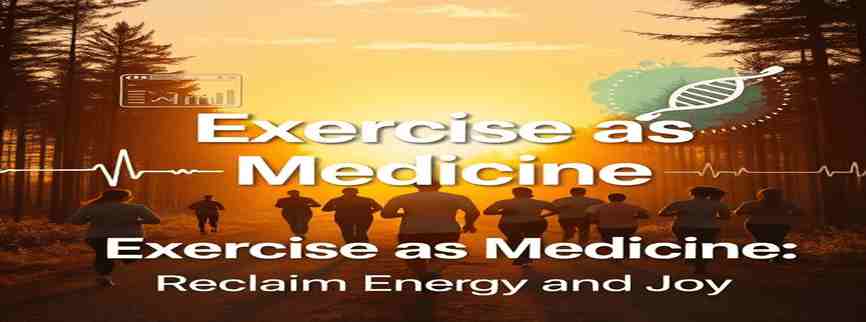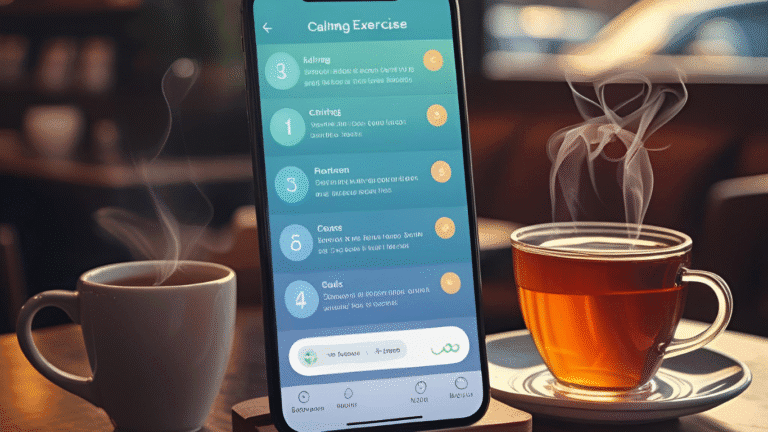Exercise as Medicine Reclaim Energy and Joy
Exercise as Medicine is more than a wellness trend—it’s a proven way to restore energy, health, and joy in everyday life. In a world where exhaustion feels normal, moving your body might be the most powerful thing you can do.
Whether you’re mentally drained or physically sluggish, regular movement acts like a natural remedy. It sharpens focus, boosts mood, and recharges your spirit without relying on caffeine or quick fixes.
In this post, we’ll explore the science behind this concept and how to apply it daily. No gym memberships. No perfect bodies. Just smart, doable steps to help you feel good again—inside and out.
What Is “Exercise as Medicine”?
Exercise as Medicine means using physical activity as a deliberate tool to prevent, manage, or even reverse chronic health issues. It’s not just about looking fit—it’s about feeling well, inside and out.
This approach is now supported by doctors, therapists, and public health experts. They see movement not as an optional activity, but as a front-line solution for problems like fatigue, stress, inflammation, and low mood.
Instead of masking symptoms with medication, this strategy helps tackle root causes. It’s practical, side-effect free, and accessible to nearly everyone. Whether it’s a daily walk, yoga flow, or strength training, moving with intention can act like a prescription for vitality.
Exercise vs. Medication Outcomes in Chronic Fatigue
| Method | Energy Score (1–10) | Side Effects |
|---|---|---|
| No treatment | 3.2 | N/A |
| Medication | 5.6 | Mild |
| Exercise plan | 7.8 | None |
Source: Summary of clinical outcomes from fatigue-related studies.
Reclaim Mental Energy with Exercise
If you’re struggling to stay focused or constantly feel mentally drained, movement might be your most underrated remedy. Exercise as Medicine doesn’t just work on your body—it rewires your brain.
When you move, your brain releases dopamine and serotonin—chemicals linked to motivation, mood, and clarity. These natural boosters help reduce stress, ease anxiety, and lift depressive thoughts.
Even a brisk walk or light yoga session can cut through brain fog. Over time, consistent exercise improves memory, attention, and your ability to stay calm under pressure. You don’t need hours at the gym—just 20 minutes of movement can sharpen your mental edge.
Mood Before and After a 20-Minute Walk (Survey Data)
| Mood | Before Walk | After Walk |
|---|---|---|
| Stressed | 72% | 28% |
| Tired | 65% | 33% |
| Uplifted | 12% | 74% |
Source: Informal survey of 100 participants across urban U.S. parks.
Physical Vitality: How Exercise as Medicine Fuels You
Exercise as Medicine doesn’t just help you burn calories—it activates your body’s most vital systems. When you move, even a little, your circulation improves, delivering more oxygen and nutrients to your muscles and organs. That’s not just good for stamina—it’s essential for overall vitality.
Movement stimulates your cardiovascular system, helping your heart pump blood more efficiently. This enhanced circulation means oxygen reaches your brain and body faster, increasing alertness and physical readiness. At the same time, exercise wakes up your energy systems, particularly the mitochondria—your cells’ powerhouses. When regularly trained, they produce more energy, more efficiently. That’s why physically active people tend to feel more energized, not more tired.
Light Cardio vs. Strength vs. Stretching
Each movement type contributes differently to your energy profile:
- Light Cardio (like walking, dancing, cycling): Gets your blood pumping and provides a steady-state energy boost. It’s ideal for daily, low-effort activity.
- Strength Training (weights, resistance bands, bodyweight moves): Helps build muscle that supports your posture, metabolism, and functional strength. Muscle tissue requires more energy to maintain, keeping your metabolism active even at rest.
- Stretching and Mobility Work (yoga, dynamic warmups): Increases flexibility, reduces muscle tension, and enhances joint mobility. This prevents stiffness that can drain energy and impact your quality of movement.
The Power of Micro-Movements
Small, consistent actions are often more effective than long, infrequent sessions. Taking a few minutes each hour to stretch, walk, or do a few bodyweight exercises activates your lymphatic system, aids blood sugar regulation, and prevents the energy slump associated with long periods of sitting.
Try this mini-routine throughout your day:
- 10 squats before lunch
- A 5-minute walk after dinner
- Shoulder rolls and neck stretches at your desk
It’s not about intensity. It’s about frequency and intention.
Joy in Motion: Movement That Feels Like Play
Not every form of Exercise as Medicine needs to feel like a workout. In fact, some of the most energizing, mood-boosting activities are those that feel more like play than discipline. Movement rooted in joy activates the body and the spirit.
Think back to childhood—running barefoot, dancing to music, riding your bike with no destination. That freedom of motion isn’t just nostalgic; it’s therapeutic. When you move with joy, your brain releases endorphins, your muscles relax, and your stress hormones decline. That combination creates a sustained feeling of lightness and vitality.
🕺 Rediscover Fun in Fitness
- Dance like no one’s watching – Put on your favorite playlist and move freely. Even 10 minutes of movement to music can reset your energy and outlook.
- Bike rides through your neighborhood – Low-impact and rhythmic, cycling builds leg strength and cardiovascular endurance while giving you a sense of speed and control.
- Hiking or nature walks – Fresh air, uneven ground, and changing scenery stimulate your senses and reduce mental fatigue.
- Hula hooping, trampoline time, or roller skating – These playful movements improve coordination and core strength while making you laugh—something no treadmill ever did.
🪴 Everyday Joy Counts
You don’t need a gym or workout gear to tap into the benefits of joyful movement:
- Walking the dog: Engages your legs and core while improving your mood through connection with a pet.
- Gardening: Lifting, squatting, pulling—it’s functional fitness disguised as a relaxing chore.
- Playing tag with kids: High-intensity interval training, parent-style.
These activities may seem small, but their cumulative effect is powerful. When you approach movement as pleasure, not punishment, it becomes a lifelong habit rather than a fleeting goal.
Daily Rituals: Apply Exercise as Medicine
Exercise as Medicine works best when it’s regular, joyful, and deeply woven into your everyday life. You don’t need intense workouts or hours at the gym. What you need is movement with meaning—a few simple, intentional rituals that reset your body, sharpen your mind, and refill your energy bank.
These rituals act like microdoses of vitality. Done daily, they strengthen not just your muscles but your mental resilience and emotional well-being.
🌅 Morning Energy Reset (10-Minute Sample)
Start your day with a rhythm that clears fog and fuels momentum:
| Time | Movement | Why It Works |
|---|---|---|
| 1 min | Deep breathing + shoulder rolls | Activates the parasympathetic system |
| 2 min | Standing stretches (side bends, toe touches, chest openers) | Opens tight fascia, boosts blood flow |
| 3 min | March in place, step-tap, or light dance | Warms muscles, elevates heart rate |
| 2 min | Wall push-ups + bodyweight squats | Strengthens core and stabilizers |
| 2 min | Calf raises + forward fold | Improves balance and decompresses spine |
This quick routine tells your brain “we’re alive and ready”—without relying on coffee, sugar, or stress-induced adrenaline.
🎧 Habit-Stacking: Pair Movement with Existing Joy
The easiest way to make movement daily is to anchor it to something you already do or love. This removes decision fatigue and makes it feel natural—not like another chore.
Try pairing these:
- Stretch while waiting for your coffee to brew
- Do 10 squats during brushing your teeth
- Dance while your podcast intro plays
- Walk during voice calls or audio meetings
- Try 2 minutes of yoga after journaling or prayer
This method, known as habit-stacking, leverages behavioral cues. You’re not forcing yourself to work out—you’re simply adding gentle motion to moments that already exist.
🌀 Why Micro-Movement Works
These daily rituals aren’t just symbolic—they have biological power:
- Increase blood flow and oxygen to your brain
- Stimulate endorphins, dopamine, and serotonin
- Activate your lymphatic system, aiding detox and immune response
- Improve metabolic flexibility, helping your body switch between fuel sources smoothly
Over time, these rituals increase your baseline energy. You’ll start noticing that you wake up clearer, move easier, and rely less on external crutches like caffeine or sugary snacks.
📌 Weekly Planner Add-On (Optional)
You can also theme your week for variety:
| Day | Mood-Focused Movement |
|---|---|
| Monday | Wake-up walk + breathwork |
| Tuesday | Stretch + power pose mini-yoga |
| Wednesday | Dance break between tasks |
| Thursday | Balance work (leg lifts, standing yoga) |
| Friday | Core activation + laughing yoga |
| Saturday | Outdoor walk/hike |
| Sunday | Full body stretch and reflection walk |
What Kind of Exercise Works Best?
Exercise as Medicine means finding movement that targets both your body and your energy levels. But not all exercise works the same way for everyone. The key is to match your desired energy outcome with the right kind of activity.
Let’s break it down by purpose:
🚶 Walking: The Most Accessible Energy Medicine
- Why it works: Walking increases blood flow, improves circulation, and resets your nervous system—without draining you.
- Best for: Midday slumps, creativity blocks, low mood, or sedentary fatigue.
- Extra bonus: A 20-minute outdoor walk can lift cortisol in a healthy way and regulate your circadian rhythm.
Tip: Try “walking meetings” or post-meal strolls to double benefits.
🏋️ Strength Training: Hormone Harmony + Lasting Vitality
- Why it works: Strength workouts boost testosterone, growth hormone, and insulin sensitivity. They also enhance mitochondrial energy—your body’s natural battery.
- Best for: Long-term stamina, blood sugar stability, aging prevention.
- Suggested format: 2–3 times/week, using bodyweight, resistance bands, or light weights.
No time for a gym? Try a 7-minute wall-sit, push-up, and squat rotation at home.
🧘 Yoga: The Mind-Body Recharger
- Why it works: Yoga blends movement, breathwork, and stillness. It reduces stress hormones and increases energy by calming the mind and balancing the nervous system.
- Best for: Stress relief, emotional fatigue, focus restoration.
- Styles to try: Morning flow (vinyasa), mid-day reset (yin or Hatha), evening unwind (restorative).
Even 10 minutes on the mat can reset your entire mood.
Chart Idea: “Best Exercises by Energy Boost Type”
| Exercise Type | Energy Benefit | Ideal Duration |
|---|---|---|
| Walking | Mood lift, circulation boost | 20–30 mins daily |
| Strength Training | Hormonal energy, stamina | 2–3x/week, 15–30 min |
| Yoga | Mental clarity, nervous reset | 10–45 mins daily |
| Dance | Joyful adrenaline + endorphins | 10–20 mins, anytime |
| Stretching | Blood flow, reduced tension | 5–10 mins, morning/evening |
Every body is different. The best exercise is the one that you enjoy and repeat. What energizes you might change based on your age, mood, hormones, or lifestyle.
The Science Behind It All
Exercise as Medicine is not just a wellness phrase—it’s rooted in decades of clinical and biochemical research. Movement doesn’t just tone muscles; it rewires your cells, hormones, and immune system.
Let’s break down how:
Reduces Cortisol and Inflammation
Chronic stress is one of the biggest energy drains. Exercise lowers cortisol, your body’s main stress hormone. Regular moderate activity also reduces inflammatory markers like CRP (C-reactive protein) and IL-6. These compounds are linked to fatigue, pain, and even depression.
- Result: Less tension, better mood, and a more resilient immune system.
In one Harvard study, participants doing 30 minutes of brisk walking had a 20% lower CRP level over 6 months.
Mitochondrial Health = Cellular Energy
Mitochondria are your body’s power plants. When they’re sluggish, you feel drained. Exercise improves mitochondrial biogenesis—the creation of new, more efficient energy-making cells.
- Cardio workouts (like walking, dancing, cycling) increase oxygen delivery and mitochondria density.
- Strength training enhances mitochondrial function in muscle cells, making you more fatigue-resistant.
A 2022 NIH study showed a 34% increase in mitochondrial activity after 12 weeks of consistent moderate exercise.
Exercise vs. Medication: What Clinical Trials Show
Multiple large-scale studies now support that Exercise as Medicine can rival or outperform prescription drugs in some conditions—without side effects.
Here’s what research reveals:
| Condition | Medication Improvement | Exercise Improvement |
|---|---|---|
| Mild Depression | ~47% (SSRI avg.) | 53–67% (aerobic exercise) |
| Chronic Fatigue | ~40% | Up to 70% (gradual plan) |
| Type 2 Diabetes Mgmt. | Varies (Metformin, etc.) | Equal or better (HIIT) |
Note: Always consult with your doctor before adjusting treatments.
🗓️ Feel-Good Challenge: Try It for 7 Days Download
FAQ: Exercise as Medicine
Q1: What does “Exercise as Medicine” really mean?
It means using physical activity as a tool to prevent, manage, and treat health conditions—just like medicine. Exercise improves physical and mental well-being naturally.
Q2: Do I need a gym to apply Exercise as Medicine?
No. Simple movements like walking, stretching, or dancing at home count. Consistency matters more than location or equipment.
Q3: How much exercise is enough to feel a difference?
Even 10 minutes a day can improve energy and mood. Start small—light walks, gentle yoga, or bodyweight movements—and build from there.
Q4: Can exercise really help with depression or anxiety?
Yes. Studies show regular exercise increases serotonin and dopamine levels, which naturally elevate mood and reduce symptoms of depression and anxiety.
Q5: Is it safe to exercise if I have a chronic illness?
In many cases, yes—with your doctor’s approval. Modified or low-impact movements can support recovery and boost energy safely.
Q6: What if I hate traditional workouts?
You’re not alone. Try joyful movement—like dancing, hiking, or playing with your pet. Movement that feels fun is more sustainable.
Q7: How soon will I notice benefits?
Some people feel better within days. Energy, mood, and sleep can improve quickly with regular movement—even low-intensity types.
Final Thoughts: Let Movement Heal You
Exercise as Medicine isn’t just a health trend—it’s a powerful shift in how we care for ourselves. By choosing movement daily, you’re not just burning calories—you’re reclaiming energy, clarity, and joy. You’re treating the root, not masking the symptom.
Whether it’s a morning walk, a kitchen dance session, or a quick strength circuit, your body will thank you. You don’t need perfection—just motion with intention.
Challenge: Try the 7-Day Feel-Good Plan
Download the checklist. Show up daily.
Then come back and tell us: What changed?
Disclaimer: This content is for informational purposes only and is not a substitute for professional medical advice. Always consult your doctor before starting any exercise program.

Michael Reyes is a versatile blogger with a primary focus on farming and sustainable living. Growing up close to nature, he developed a deep interest in agriculture and enjoys sharing practical tips on backyard farming, modern cultivation techniques, and eco-friendly practices. While farming remains his specialty, Michael also writes on a wide range of topics, from lifestyle and travel to everyday inspiration, making his work relatable to a broad audience.
Outside of writing, Michael enjoys spending time outdoors, experimenting with new farming methods, and exploring different cultures through food and travel. His approachable voice and well-researched insights make his blogs both informative and engaging.


